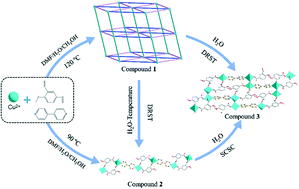当前位置:
X-MOL 学术
›
CrystEngComm
›
论文详情
Our official English website, www.x-mol.net, welcomes your
feedback! (Note: you will need to create a separate account there.)
Single-crystal-to-single-crystal (SCSC) transformation and dissolution–recrystallization structural transformation (DRST) among three new copper(ii) coordination polymers†
CrystEngComm ( IF 2.6 ) Pub Date : 2017-12-15 00:00:00 , DOI: 10.1039/c7ce01919j Xiao-Feng Zhang 1, 2, 3, 4, 5 , Tong Yan 1, 2, 3, 4, 5 , Tao Wang 1, 2, 3, 4, 5 , Jing Feng 1, 2, 3, 4, 5 , Quan Wang 1, 2, 3, 4, 5 , Xiao Wang 1, 2, 3, 4, 5 , Lin Du 1, 2, 3, 4, 5 , Qi-Hua Zhao 1, 2, 3, 4, 5
CrystEngComm ( IF 2.6 ) Pub Date : 2017-12-15 00:00:00 , DOI: 10.1039/c7ce01919j Xiao-Feng Zhang 1, 2, 3, 4, 5 , Tong Yan 1, 2, 3, 4, 5 , Tao Wang 1, 2, 3, 4, 5 , Jing Feng 1, 2, 3, 4, 5 , Quan Wang 1, 2, 3, 4, 5 , Xiao Wang 1, 2, 3, 4, 5 , Lin Du 1, 2, 3, 4, 5 , Qi-Hua Zhao 1, 2, 3, 4, 5
Affiliation

|
In this work, water- and temperature-induced single-crystal-to-single-crystal (SCSC) transformation and dissolution–recrystallization structural transformation (DRST) are observed among three new copper(II) coordination polymers, {[Cu5(μ3-OH)2(MIPA)4(4,4′-bpy)2]·2H2O}n (1), {[Cu(H2O)2(MIPA)(4,4′-bpy)0.5]·H2O}n (2) and {[Cu2(H2O)2(MIPA)2(4,4′-bpy)(μ2-H2O)]·3H2O}n (3) (MIPA = 4-methoxyisophthalic acid, 4,4′-bpy = 4,4′-bipyridine). The 3D framework of 1 experienced an intensive DRST process to form the 1D intermediate of 2, followed by a unique SCSC process to transform it into the 2D network of 3. Nevertheless, compound 3 can be obtained from compound 1 directly via another DRST. That is to say, a DRST process could be achieved by the combination of another DRST process and an SCSC process. To the best of our knowledge, this type of study is still scarce. And it provides a convenient strategy to investigate the mechanism of crystal transformation and construct advanced crystalline materials. Results have been characterized by single crystal X-ray diffraction and powder X-ray diffraction (PXRD). Significant structural alterations were observed and these changes could be analyzed from the properties of center Cu(II) ions and the switch of chelating-bridging modes of MIPA. Magnetic susceptibility measurements indicate that 1 and 3 exhibit antiferromagnetic interaction between adjacent Cu(II) centers. Additionally, complexes 1–3 have been characterized by thermogravimetric analysis and infrared and PXRD studies.
中文翻译:

三种新型铜(ii)配位聚合物之间的单晶至单晶(SCSC)转变和溶解-再结晶结构转变(DRST)†
在这项工作中,在三种新型的铜(II)配位聚合物中{{Cu 5(μ 3 -OH)2(MIPA)4(4,4'-bpy)2 ]·2H 2 O} n(1),{[Cu(H 2 O)2(MIPA)(4,4'-bpy)0.5 ]·H 2 O} n(2)和{[Cu 2(H 2 O)2(MIPA)2(4,4'-bpy)(μ2 -H 2 O)]·3H 2 O} n( 3)(MIPA = 4-甲氧基间苯二甲酸,4,4′-bpy = 4,4′-联吡啶)。的三维框架1经历一个密集DRST工艺以形成的1D中间体2,随后是独特SCSC过程将它转变成的2D网络3。尽管如此,化合物3可以从化合物获得1直接通过另一个DRST。也就是说,可以通过将另一个DRST过程和SCSC过程相结合来实现DRST过程。据我们所知,这种类型的研究仍然很少。它为研究晶体转变机理和构建高级晶体材料提供了方便的策略。结果已通过单晶X射线衍射和粉末X射线衍射(PXRD)进行了表征。观察到显着的结构变化,这些变化可以从中心Cu(II)离子的性质和MIPA螯合桥键模式的转换进行分析。磁化率测量表明1和3在相邻的Cu(II)中心。此外,配合物1-3已通过热重分析以及红外和PXRD研究进行了表征。
更新日期:2017-12-15
中文翻译:

三种新型铜(ii)配位聚合物之间的单晶至单晶(SCSC)转变和溶解-再结晶结构转变(DRST)†
在这项工作中,在三种新型的铜(II)配位聚合物中{{Cu 5(μ 3 -OH)2(MIPA)4(4,4'-bpy)2 ]·2H 2 O} n(1),{[Cu(H 2 O)2(MIPA)(4,4'-bpy)0.5 ]·H 2 O} n(2)和{[Cu 2(H 2 O)2(MIPA)2(4,4'-bpy)(μ2 -H 2 O)]·3H 2 O} n( 3)(MIPA = 4-甲氧基间苯二甲酸,4,4′-bpy = 4,4′-联吡啶)。的三维框架1经历一个密集DRST工艺以形成的1D中间体2,随后是独特SCSC过程将它转变成的2D网络3。尽管如此,化合物3可以从化合物获得1直接通过另一个DRST。也就是说,可以通过将另一个DRST过程和SCSC过程相结合来实现DRST过程。据我们所知,这种类型的研究仍然很少。它为研究晶体转变机理和构建高级晶体材料提供了方便的策略。结果已通过单晶X射线衍射和粉末X射线衍射(PXRD)进行了表征。观察到显着的结构变化,这些变化可以从中心Cu(II)离子的性质和MIPA螯合桥键模式的转换进行分析。磁化率测量表明1和3在相邻的Cu(II)中心。此外,配合物1-3已通过热重分析以及红外和PXRD研究进行了表征。











































 京公网安备 11010802027423号
京公网安备 11010802027423号